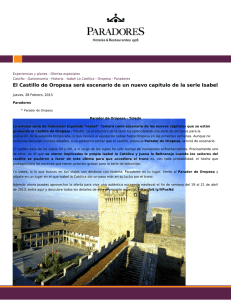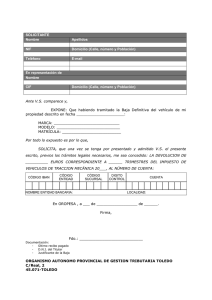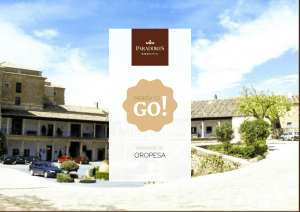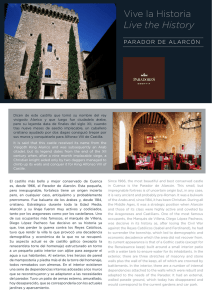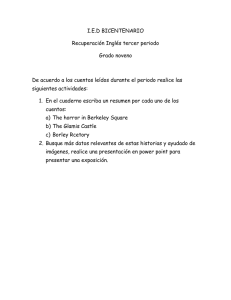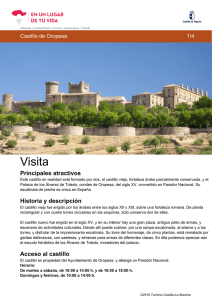Folleto Vive la Historia. Parador de Oropesa
Anuncio
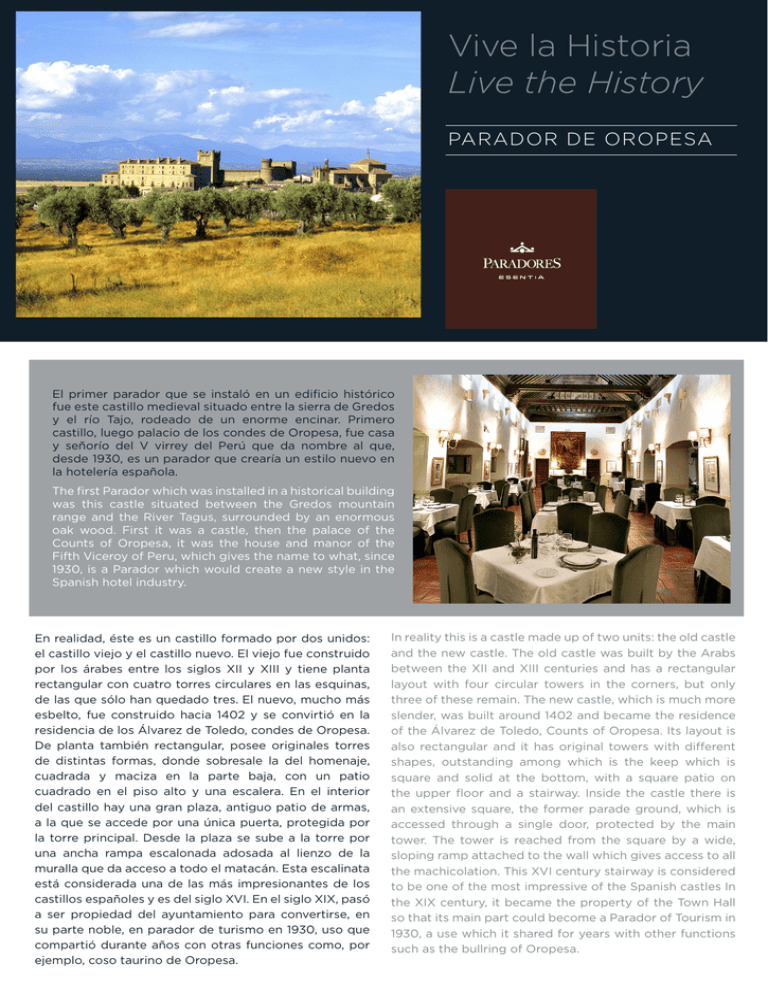
Vive la Historia Live the History PARADOR DE OROPESA El primer parador que se instaló en un edificio histórico fue este castillo medieval situado entre la sierra de Gredos y el río Tajo, rodeado de un enorme encinar. Primero castillo, luego palacio de los condes de Oropesa, fue casa y señorío del V virrey del Perú que da nombre al que, desde 1930, es un parador que crearía un estilo nuevo en la hotelería española. The first Parador which was installed in a historical building was this castle situated between the Gredos mountain range and the River Tagus, surrounded by an enormous oak wood. First it was a castle, then the palace of the Counts of Oropesa, it was the house and manor of the Fifth Viceroy of Peru, which gives the name to what, since 1930, is a Parador which would create a new style in the Spanish hotel industry. En realidad, éste es un castillo formado por dos unidos: el castillo viejo y el castillo nuevo. El viejo fue construido por los árabes entre los siglos XII y XIII y tiene planta rectangular con cuatro torres circulares en las esquinas, de las que sólo han quedado tres. El nuevo, mucho más esbelto, fue construido hacia 1402 y se convirtió en la residencia de los Álvarez de Toledo, condes de Oropesa. De planta también rectangular, posee originales torres de distintas formas, donde sobresale la del homenaje, cuadrada y maciza en la parte baja, con un patio cuadrado en el piso alto y una escalera. En el interior del castillo hay una gran plaza, antiguo patio de armas, a la que se accede por una única puerta, protegida por la torre principal. Desde la plaza se sube a la torre por una ancha rampa escalonada adosada al lienzo de la muralla que da acceso a todo el matacán. Esta escalinata está considerada una de las más impresionantes de los castillos españoles y es del siglo XVI. En el siglo XIX, pasó a ser propiedad del ayuntamiento para convertirse, en su parte noble, en parador de turismo en 1930, uso que compartió durante años con otras funciones como, por ejemplo, coso taurino de Oropesa. In reality this is a castle made up of two units: the old castle and the new castle. The old castle was built by the Arabs between the XII and XIII centuries and has a rectangular layout with four circular towers in the corners, but only three of these remain. The new castle, which is much more slender, was built around 1402 and became the residence of the Álvarez de Toledo, Counts of Oropesa. Its layout is also rectangular and it has original towers with different shapes, outstanding among which is the keep which is square and solid at the bottom, with a square patio on the upper floor and a stairway. Inside the castle there is an extensive square, the former parade ground, which is accessed through a single door, protected by the main tower. The tower is reached from the square by a wide, sloping ramp attached to the wall which gives access to all the machicolation. This XVI century stairway is considered to be one of the most impressive of the Spanish castles In the XIX century, it became the property of the Town Hall so that its main part could become a Parador of Tourism in 1930, a use which it shared for years with other functions such as the bullring of Oropesa. FRANCISCO ÁLVAREZ DE TOLEDO Y FIGUEROA El miembro más destacado del linaje de los condes de Oropesa fue Francisco Álvarez de Toledo y Figueroa (1515-1582) nombrado por Felipe II virrey de Perú entre 1569 y 1581. No fue un virrey cualquiera, a él se atribuye la verdadera organización del virreinato al que dotó de un marco jurídico y económico que se mantuvo intacto hasta el siglo XVIII. El V conde de Oropesa fue toda su vida un fiel servidor a la Corona. Acompañó al emperador Carlos V en sus empresas por África y Europa e incluso le acogió temporalmente en su castillo de Jarandilla tras su abdicación. La confianza que le demostró su hijo Felipe II demuestra su estrecha relación con los reyes. Al frente del virreinato del Perú hizo valer los intereses de España en su nuevo imperio pero también tomó algunas decisiones muy polémicas como la ejecución de Tupac Amaru, el último de los reyes incas, o el restablecimiento de la mita, un sistema de producción minero extremadamente duro que diezmó a la población indígena. FRANCISCO ÁLVAREZ DE TOLEDO Y FIGUEROA The most outstanding member of the lineage of the Counts of Oropesa was Francisco Álvarez de Toledo y Figueroa (1515-1582) appointed Viceroy of Peru by Felipe II and served from 1569 to 1581. He was not just any Viceroy. He is attributed with the real organisation of the Viceroyalty which he provided with a legal and economic framework which remained intact until the XVIII century. The Fifth Count of Oropesa was a loyal server of the Crown during all his lifetime. He accompanied the Emperor Carlos V in his undertakings in Africa and Europe and even provided temporary accommodation for the Emperor in his castle of Jarandilla after his abdication. The trust he demonstrated with the Emperor’s son Felipe II showed his close relationship with the monarchs. As Viceroy of Peru he asserted the interests of Spain in its new empire, but he also took some very polemic decisions such as the execution of Tupac Amaru, the Last King of the Incas, and the establishment of the mita, a mine production system which was extremely harsh and decimated the indigenous population. La torre del homenaje es el elemento más llamativo del castillo. Es cuadrada e impresionantemente alta con 25 metros y cinco plantas. Está rematada por cuatro garitas defensivas y por grandes almenas debajo de las cuales una banda de matacanes soporta el peso. En las garitas, los escudos de armas de Fernando Álvarez de Toledo, cuarto señor de Oropesa. The keep is the most outstanding component of the castle. It is square shaped and impressively high at 25 metres and with five floors. It is crowned by four defensive sentry boxes and by large battlements below which a machicolation band supports the weight. The coats of arms of Fernando Álvarez de Toledo, the Fourth Lord of Oropesa are on the sentry boxes. TAMBIÉN LE GUSTARÁ: YOU WILL ALSO LIKE THE FOLLOWING: Paseo a pie por Oropesa. Walking through Oropesa Talavera de la Reina. Talavera de la Reina Categoría: Palacio y Castillo Fecha: 1930 Arquitecto: Luis Martínez-Feduchi Ruiz BIC: Monumento Category: Palace and Castle Date: 1930 Architect: Luis Martínez-Feduchi Ruiz BIC (Property of Cultural Interest): Monument
